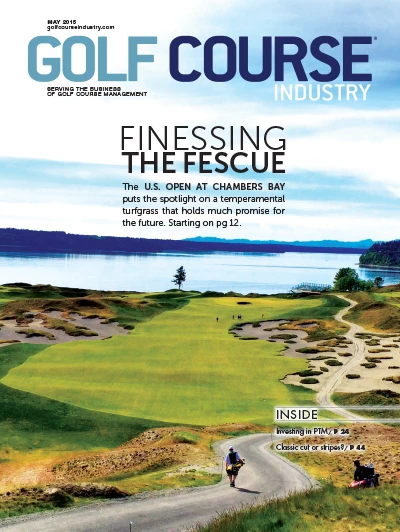 While almost every club today is faced with the issue of course renovation, pulling the trigger on that project has never been so difficult.
While almost every club today is faced with the issue of course renovation, pulling the trigger on that project has never been so difficult.
It used to be simpler: the reasons for renovation piled up (irrigation system, bunker drainage, turf conditions on the greens), money was amassed or financed, and all underperforming course elements were addressed as part of a comprehensive renovation. Those days are gone. Course issues continue to pile up, naturally, but club finances and prevailing market forces now oblige clubs to peck away at these upgrades, one or two at a time – while always keeping the course open (and revenues flowing).
We’ve talked in this space before about the need for superintendents to compile and maintain long-term course maintenance plans. A major reason why: To chart and prioritize course elements in need of upgrade. In this age of selective renovation, this has never been more important.
But let’s take things a couple steps further, because any such long-term maintenance plan must be considered in light of the club’s position in the local marketplace. This is information that superintendents, general managers and board members often operate without. Put simply, if your bunkers don’t drain well, but every other club in the market has the same issue, correcting this problem isn’t so pressing. If all the bunkers at competing clubs make yours look sick, that equation is changed.
When one lays these competitive, market factors on top of a prioritized list of course-upgrade imperatives, it brings into focus what should be done, when it should be done, and why.
This is a more sophisticated, efficient way of assessing your course renovation needs. Most clubs simply do not have an intimate knowledge of their competitive marketplaces. Up until now, this is an area of operational context in which they have not invested.
These more nuanced assessments of renovation/reinvestment needs also require an additional understanding of course value and course-component value – what a new set of regrassed greens will actually mean in terms of attracting/keeping members, raising or maintaining green fees, etc. This understanding cannot be achieved without market analysis, either.
Let’s assume the superintendent has created and curated a long-term maintenance plan for a private club. In other words, it’s been established what the course needs in terms of renovation, and the order of projects has been prioritized. As such, the remaining questions facing club leaders are the classic “who, what, when, why & how” inherent to any storytelling guide.
What
We’ve established the trusty superintendent has already produced an objective, up-to-date analysis of the club’s golf course components. Is the club engaged in ongoing maintenance and investment vis-a-vis its non-course-related facilities? If not, the same long-term analysis must be conducted to identify/prioritize those facility components that require attention. Such a study may well require professionals in market analysis, clubhouse design, agronomy or engineering disciplines. In short, a comprehensive facilities analysis will assess the property’s physical condition, as well as its potential positioning in the marketplace.
Why
On one level, this is the easiest portion of any analysis. Internally, a club can see exactly why drainage issues are resulting in golfer dissatisfaction. Externally, a club is flying blind if it doesn’t have a comprehensive understanding of drainage issues (and a dozen more salient factors) at the clubs/courses with which it competes. Internal assessment is vital. Market understanding is vital. But without both, working together in tandem, clubs cannot make accurate calls on why this project should be done now, and why that one could wait. Which leads us to…
When
Again, internally, the superintendent, the GM and the board should have a real solid understanding of what renovation project, if undertaken, would mollify the most dissatisfied members. Let’s say it’s the greens, which are full of Poa and need regrassing. When this established element overlaps with competitive imperatives (in the form of competing clubs whose greens are putting yours to shame), this becomes Priority 1 with a bullet – the project to undertake this fall, not next fall. I think you can see how a dozen course improvements on a long-term plan could be effectively prioritized when viewed through these two vital lenses.
Who
This refers to the team that will implement the project, or has been involved in the planning: the club’s market/economic consultant, golf course architect, clubhouse/facilities architect, construction providers, the in-house maintenance crew. It goes without saying they should all be willing to work together and add their professional expertise to the long-term planning effort and the prioritization effort.
How
Here’s where it gets fun because “how” to fund these projects, even smaller renovations, can be tricky. Funding strategies represent a third layer of planning that must be laid across the club’s long-term plans/priorities and its thorough market analysis. Synthesizing this third layer also requires the cooperation and brainpower of your staff, in concert with all these vendors listed above in the Who section. For example, the green re-grassing project: Does it make sense to address greenside bunker drainage as part of this project? It will add thousands to the price tag, but those greens will be closed anyway for re-grassing, so golfers won’t be further inconvenienced. If the greens are regrassed only, perhaps the club can cover the cost with a one-time assessment; if bunkers are added, perhaps financing will be required.
In short, the “how” is where the other elements of planning come together, where the rubber meets the road. Sometimes clubs will determine that they must be financially healthy in order to embark on portions of a renovation plan. Others take the view that it might take these renovations in order to achieve that financial health.
Each club is unique in this way. However, I wouldn’t want to make that call unless I had a thorough understanding of how my club compares to competing clubs.
More universal is the importance of “stewardship,” a word used more and more in the golf business these days. There is environmental stewardship, something superintendents embody, and have for decades. In today’s challenging economic climate, however, club stewardship has taken on equal, if not primary importance. If the club goes bust, that environmentally responsible golf course goes bust, too.
An immense amount of planning and preparation should go into efficient, responsible, “winning” club stewardship. Members must buy into this ethos. They must actively choose to pass on a better club to the next generation. Every club has its factions, it obstructionists. This only underlines the need to have long-term renovation/improvement/investment plans in place for the course and all club facilities. These document are road maps, of course, but they also serve to create continuity from board to board, from generation to generation.
Just remember that planning documents are working documents – they are continually updated, as time passes, physical situations change and projects get ticked off. Markets change, too. And so clubs require up-to-date market analyses to allow effective interpretation of those plans from year to year.
Laurence A. Hirsh, CRE, MAI, SGA, FRICS is the president of Golf Property Analysts based in Philadelphia, and a frequent GCI contributor.
Get curated news on YOUR industry.
Enter your email to receive our newsletters.
Explore the May 2015 Issue
Check out more from this issue and find your next story to read.
Latest from Golf Course Industry
- Advanced Turf Solutions’ Scott Lund expands role
- South Carolina’s Tidewater Golf Club completes renovation project
- SePRO to host webinar on plant growth regulators
- Turfco introduces riding applicator
- From the publisher’s pen: The golf guilt trip
- Bob Farren lands Carolinas GCSA highest honor
- Architect Brian Curley breaks ground on new First Tee venue
- Turfco unveils new fairway topdresser and material handler





